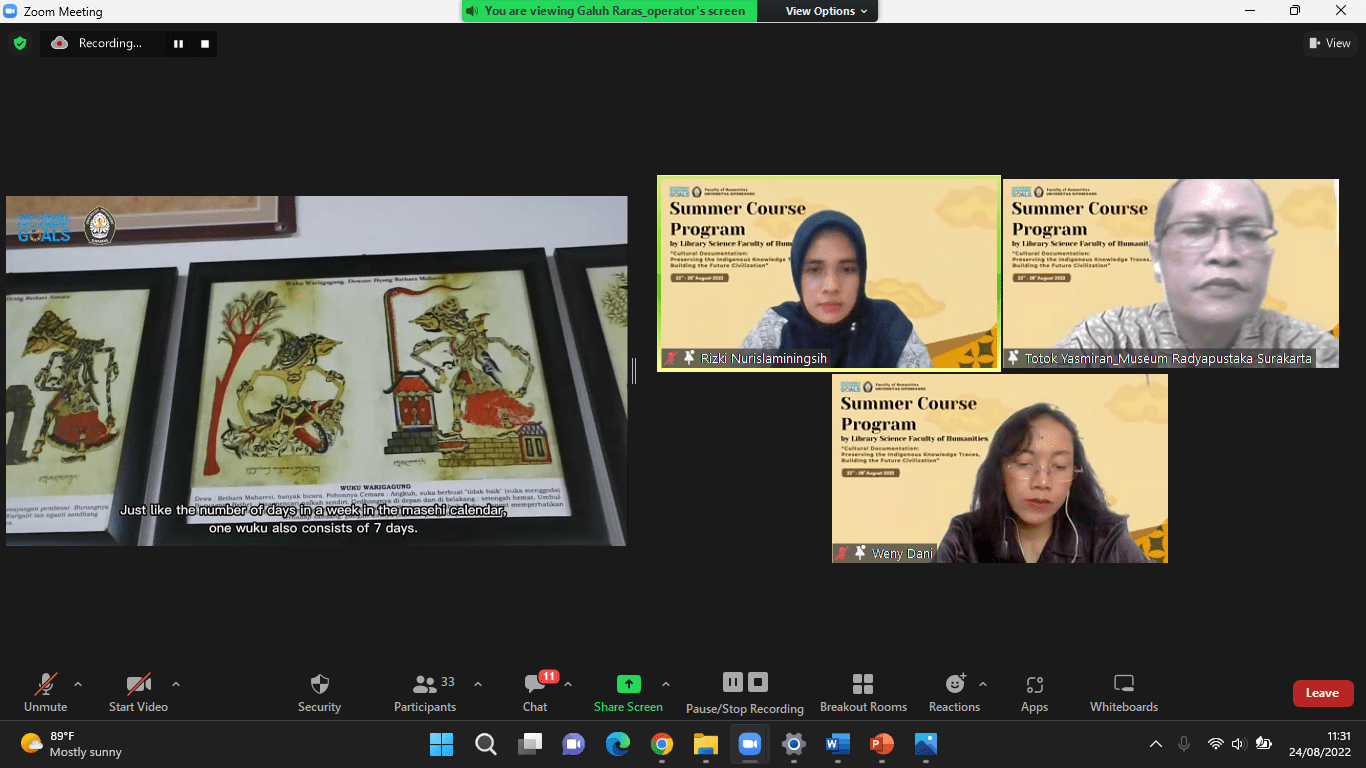An international summer course with the theme “Cultural Documentation: Preserving the Indigenous Knowledge Traces, Building the Future Civilization” was hosted by Diponegoro University’s library science study program.
On the third day of the summer course was separated into two sessions. Kusnandar S.Sos, M.Si. (Ph.D. Candidate – Leiden University), introduced the first session’s theme, “Artifact as the Trace Civilization,” accompanied by Nur’aini Perdani S.P, M.A., as moderator.
Mr. Kusnandar S.Sos, M.Si (Ph.D. Candidate – Leiden University), who introduced the topic, said that civilization is a stage of cultural development that dates from a particular time or location where the stage of human social development and organization is considered to be the most advanced. characterized by five factors: sophisticated cities, skilled labor, intricate institutions, record-keeping, and cutting-edge technology. While artifacts are human-made items like tools, clothing, and works of art that date back in time and space. Artifacts are any items made or altered by human society, individuals, or groups that are discovered through archaeological efforts or by coincidence after being utilized for their intended purpose.
Archaeology is a field of study that explores the history of humanity using artifacts, or any object that has been manufactured, altered, or used by humans. In archeology, objects might be everything from sarcophagi to silverware to statues to jewelry to works of art. There are five methods to view historical artifacts. The question of what constitutes an artifact is tied to the first way in which it communicates its own tale. It was created when? What source does it have? Establish fundamental facts about items in order to recognize and situate them in time and space. The second is using artifacts to link people together and uncover narratives about the function of objects in human existence. The third is in the form of objects that have multiple meanings; when meaning, value, and significance are taken into account in the context of cultural history, objects express ideas, embody ideals, and evoke feelings. the subsequent in the form of artifacts as a way of preserving a historical moment, a time capsule, representing the preferences and ideals of an era, to signify the stage of technical development. Artifacts also show alterations over time. The ability of artifacts to improve the story comes last.
Rizki Nurislaminingsih, M.A., (Lecturers at Padjadjaran University). Totok Yasmiran S.S. and Weny Kritandani as translator, presented the following material after a series of discussion sessions. “Radya Pustaka: The Artifact of Javanese Indigenous Knowledge,”
Manager of Old Manuscripts and Consultant for Pawukan Museum Radya Pustaka, Mr. Totok Yasmiran S.S. He went on to say that the Radya Pustaka Museum, which is situated in Sriwedari, Laweyan District, Surakarta City, is the oldest museum in Indonesia and was established by Kanjeng Raden Adipati Sosrodiningrat IV on October 28, 1890. According to etymology, “Pustaka” means letter and “Radya” signifies government. This location was originally meant to preserve royal letters, but over time it also served as a storage facility for other significant items connected to the kingdom.
A statue of Rangga Warsita may be found in the museum’s courtyard. The first of the museum’s seven rooms is used to store puppets. The Tosan Aji chamber, where metal weapons, statues, and miniature joglo dwellings are kept, is the second room. The third chamber also houses a variety of pottery that date back to the Dutch colonial era. A library with a large concentration of Dutch and Javanese language materials is located in the fourth space. The fifth room is a chamber where numerous bronze collections, including statues and gamelan, are kept. The large gamelan that belongs to Kanjeng Raden Adipati Sosrodiningrat IV is kept in the Ethno chamber, the sixth room, which is next to it.
The series of events on the third day of the summer course closed with video screenings from the Radya Pustaka Museum and the Surakarta Kasunanan Palace.

